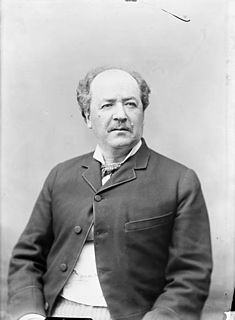Salomon Hamelin (April 6, 1810 – September 10, 1893) was a political figure in Manitoba. He served in the Legislative Council of Manitoba from 1871 to 1876. [1]

Manitoba is a province at the longitudinal centre of Canada. It is often considered one of the three prairie provinces and is Canada's fifth-most populous province with its estimated 1.3 million people. Manitoba covers 649,950 square kilometres (250,900 sq mi) with a widely varied landscape, stretching from the northern oceanic coastline to the southern border with the United States. The province is bordered by the provinces of Ontario to the east and Saskatchewan to the west, the territories of Nunavut to the north, and Northwest Territories to the northwest, and the U.S. states of North Dakota and Minnesota to the south.
The Legislative Council of Manitoba was the upper house of the Legislature of Manitoba. Created in 1870 and abolished in 1876, the council was the only provincial upper house in Canada that was not a direct or indirect continuation of a pre-confederation upper house. It was also the first provincial upper house to be abolished.
He was the son of Jacques Hamelin and Angelique Tourengeau. In 1831, he married Isabella Vandale. Hamelin ran unsuccessfully for a seat in the Legislative Assembly of Manitoba in 1878, losing to Joseph Royal. He died in Sainte Rose du Lac at the age of 83. [1]

Joseph Royal was a Canadian journalist, lawyer, politician, businessman, and Lieutenant Governor of the Northwest Territories.
His grandson Joseph Hamelin served in the Manitoba legislative assembly. [1] The singer Ray St. Germain is also a descendent of Hamelin. [2]
Joseph Hamelin was a politician in Manitoba, Canada. He served in the Legislative Assembly of Manitoba from 1914 to 1927. Hamelin's paternal grandfather, Salomon Hamelin, served in the Legislative Council of Manitoba from 1871 to 1876. His maternal grandfather was legislator Pascal Breland.
Ray St. Germain is a Canadian musician, author, and radio show host. He was the 2006 federal Liberal candidate for the Winnipeg Centre constituency and the presenter for the 1969 Canadian variety television series Time for Living. He was inducted into the Canadian Country Music Hall of Honour by the Canadian Country Music Association in September 2010. St. Germain's autobiography, "I Wanted to Be Elvis, So What Was I Doing in Moose Jaw?" was published by Pemmican Publications Inc. in 2005.